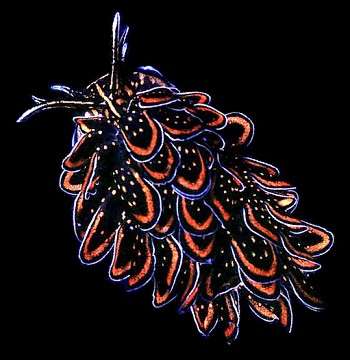
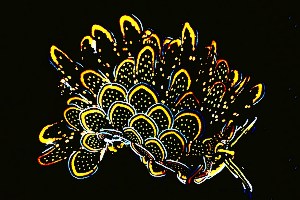
Cyerce nigricans
(Pease, 1866)
Order: SACOGLOSSA
Superfamily: LIMAPONTIOIDEA
Family: Caliphyllidae
DISTRIBUTION
Originally described by Pease from the `Pacific Islands', it is widely distributed in the Indo-West Pacific.
PHOTO
UPPER: Guam, Bile Bay, reef flat; 22mm long; 2 April 1971. Host: Chlorodesmis fastigiata. PHOTO: Clay Carlson.
LOWER: Reef flat near Gorgonia Hole, Heron Is, Great Barrier Reef, Queensland, May 1981. PHOTO: Bill Rudman.
Although most species of Cyerce, and the related genus, Polybranchia, are cryptically coloured, Cyerce nigricans breaks the rule. It is one of the 'icon' species of the Great Barrier Reef, often being used in tourist posters and brochures. As with many brightly coloured sea slugs this species produces distasteful secretions, and the cerata are easily cast (autotomy)when the animal is disturbed. Distasteful secretions and autotomy are two common defensive strategies sea slugs use against predatory fish.
I have put a 'species' or 'colour form' described by Bergh from Palau as Cyerce nigra, on a separate page. It seems to have consistent colour differences.
Reference:
• Pease, W.H. (1866). Remarks on nudibranchiata inhabiting the Pacific islands, with descriptions of two new genera. American Journal of Conchology 2(2): 204-208.
Rudman, W.B., 1999 (July 6) Cyerce nigricans (Pease, 1866). [In] Sea Slug Forum. Australian Museum, Sydney. Available from http://www.seaslugforum.net/find/cyernigr
Related messages
Cyerce nigricans from sthn Queensland, Australia
April 11, 2008
From: Bruce Wilkie
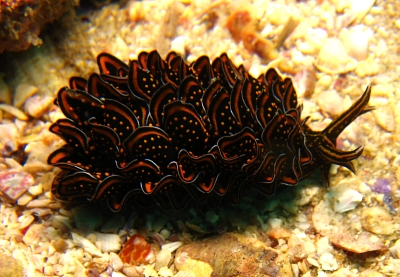
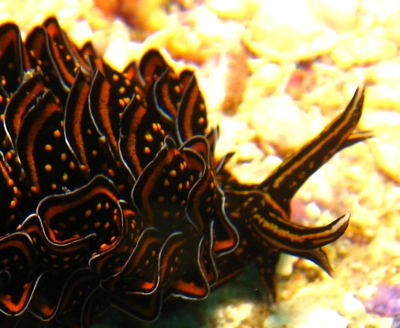
Hi Bill,
I thought I would send you some photos of what I think is Cyerce nigricans. It fills in another gap in their distribution.
Locality: Shag Rock, Point Lookout, North Stradbroke Island. , 10 m, Queensland, Australia. Pacific ocean., 21 April 2007, Rocky reef, hard and soft corals, sponges.. Length: 30 mm. Photographer: Bruce Wilkie.
Many thanks,
Bruce Wilkie.
brucedwilkie@yahoo.com.au
Wilkie, B, 2008 (Apr 11) Cyerce nigricans from sthn Queensland, Australia. [Message in] Sea Slug Forum. Australian Museum, Sydney. Available from http://www.seaslugforum.net/find/20961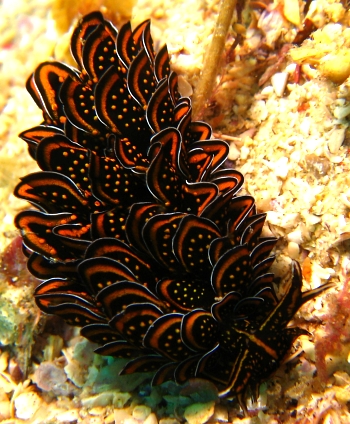
Thanks Bruce,
This is indeed Cyerce nigricans - as distinct from Cyerce nigra. My Latin is not good enough to tell me whether nigricans should be blacker than nigra but it is a pain that these two very similar descriptive names will always be around to confuse us.
Best wishes,
Bill Rudman
Cyerce nigricans from the Solomon Ids
April 21, 2005
From: Bruce Potter
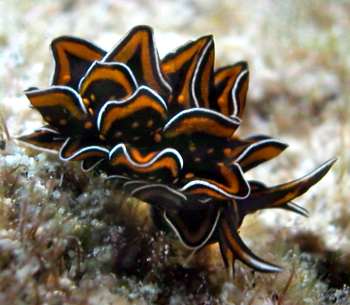
Dear Bill,
I almost missed this little Cyerce nigricans, as I was exiting at the end of a dive. It was only about 7 mm long in about 2 meters of water. This is on a coral and rubble site on the outskirts of Honiara.
Locality: Honiara, Solomon Islands, Pacific Ocean. Depth: 2 meters. Length: 7 mm. 26 December 2004. Coral Rubble Sand. Photographer: Bruce Potter
Regards
Bruce.
bandppotter@bigpond.com.au
Potter, B., 2005 (Apr 21) Cyerce nigricans from the Solomon Ids. [Message in] Sea Slug Forum. Australian Museum, Sydney. Available from http://www.seaslugforum.net/find/13529Thanks Bruce,
Bill Rudman
Cyerce nigricans from Tahiti
February 22, 2002
From: Taiana Darius
Dear Bill,
Many thanks for your answer and the beautiful photos of Cyerce nigricans. This is it. I am very happy to know the name of this beautiful animal. I hope to find Cyerce nigricans again and I will try to get some photos.
Yours sincerely,
Taiana Darius
Laboratoire de Recherche sur les Microalgues Toxiques
Institut Louis Malardé
B. P. 30 Papeete
Tahiti
tdarius@ilm.pf
Darius, T., 2002 (Feb 22) Cyerce nigricans from Tahiti. [Message in] Sea Slug Forum. Australian Museum, Sydney. Available from http://www.seaslugforum.net/find/6332Tropical sea slug from Huahine
February 16, 2002
From: Taiana Darius
This week-end in Huahine lagoon (French Polynesia), I have seen a black sea slug with many " wings" on the back decorated with a blue line alongside and orange spots. This sea slug was tiny, about 1 cm /0.39 inch. Unfortunately, I did not have a camera with me. Is anybody can give me information about this beautiful sea slug despite my poor information request.
Many thanks to all.
Taiana
tdarius@ilm.pf
Darius, T., 2002 (Feb 16) Tropical sea slug from Huahine. [Message in] Sea Slug Forum. Australian Museum, Sydney. Available from http://www.seaslugforum.net/find/6234Dear Taiana,
I am afraid the information you have given us is a little lacking in detail but one possibility is Cyerce nigricans. Have a look at the photos on that page and see if it fits your animal. In small animals like yours the white edge could appear blue. Of course I could be quite wrong. There's no point in giving you any information about your slug until we know what it is so let me know how close I am to identifying your slugs.
Best wishes.
Bill Rudman
Cyerce nigra? from Mozambique
July 8, 2001
From: Ian Miller
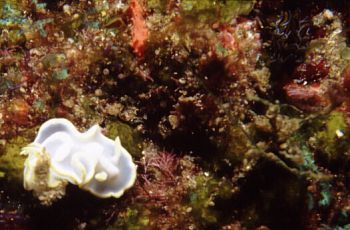
Dear Bill,
While studying a slide of what I think is Glossodoris pallida, I found what I think is a very small specimen of Cyerce nigra, size 5 mm in the top right hand corner of the slide. I know it is not too clear, but is my ID correct? If so, what is the maximum size of this animal and what does it normally feed on?
Thanks
Ian Miller
diverian@xsinet.co.za
Miller, I., 2001 (Jul 8) Cyerce nigra? from Mozambique. [Message in] Sea Slug Forum. Australian Museum, Sydney. Available from http://www.seaslugforum.net/find/4718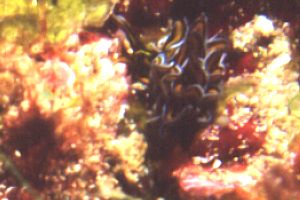
Dear Ian,
With a bit of digital magic I have enlarged and brightened up the top right corner of your photo. It certainly looks like a Cyerce but from the colour I can see in the cerata I think your animal is Cyerce nigricans rather than Cyerce nigra. Your animal has a white margin then a back then an orange-yellow band, while in C. nigra the edge is black followed by an orange-yellow band. Have a look at Bernard Picton's photos from East Africa. As to size, they grow to 30-40mm long. In the West Pacific they feed on the green algae Chlorodesmis fastigiata, unfortunately I haven't a photo to illustrate it for you. And yes the white chromodorid is Glossodoris pallida.
Best wishes,
Bill Rudman
Cyerce nigricans from East Africa
February 2, 2001
From: Bernard Picton
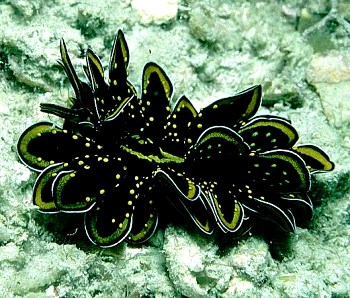
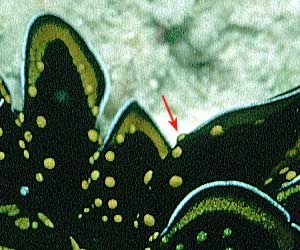
Hi Bill,
Just to confirm the wide distribution of Cyerce nigricans here is a picture
of one from Pemba Island, Tanzania (Feb 1999). Strangely enough I've never seen this conspicuous species in Indonesia or the Philippines. I noticed that it flaps its 'cerata' when disturbed and that the orange spots on the inside surfaces are raised bumps arranged in a single row around each ceras. [see second picture] Are these glands secreting the noxious substance which
make it distasteful to fish? Clay Carlson's picture of a juvenile Cyerce nigra also shows these structures. In Cyerce nigricans they seem to be mimicked by similar coloured spots on the outer (ventral) surface of the cerata.
Bernard
bernard.picton.um@nics.gov.uk
Picton, B. , 2001 (Feb 2) Cyerce nigricans from East Africa. [Message in] Sea Slug Forum. Australian Museum, Sydney. Available from http://www.seaslugforum.net/find/3684Dear Bernard,
Thanks for the East African record. There are a number of publications on the chemical secretions of Cyerce nigricans and Cyerce cristallina. I sectioned the cerata of C. nigricans many years ago and those bumps are clearly glandular but I don't know if anyone has published anything definitely locating the actual site of the icthyotoxic mucus secretions.
Two references on Cyerce nigricans are:
• Hay, M. E., Pawlik, J.R., Duffy, J.E. & Fenical,W (1989) Secondary metabolites of the chemically rich ascoglossan Cyerce nigricans. Experientia, 46: 327-329
• Roussis, V., Pawlik, J.R., Hay, M.E. & Fenical,W (1990) Seaweed-herbivore-predator interactions: host-plant specialization reduces predation in small herbivores. Oecologia, 81: 418-427.
There has also been some interesting work on the related Mediterranean Cyerce cristallina which produces a number of compounds (polyproprionate pyrones) which have been called cyercenes. Small epithelial glands in the cerata produce these cyercenes which are secreted as an icthyotoxic mucus [distasteful to fish] to protect Cyerce from fish attack. As part of the defensive strategy the cerata easily break off [autotomise] (deliberately break off) and wriggle around, secreting nasty compounds, apparently to distract the potential predator. Another metabolite 'Cyercene-A' is apparently involved in inducing the regrowth of cerata, and cerata are reported to regenerate in the incredibly short time of 8-10 days.
Three references this work on C. cristallina are:
• Vardaro, RR., Di Marzo, V., Crispino,A., & Cimino, G (1991) Cyercenes, novel polypropionate pyrones from the autotomizing Mediterranean mollusc Cyerce cristallina. Tetrahedron, 47(29): 5569-5576.
• Di Marzo, V., Vardaro, RR., De Petrocellis, L., Villani, G., Minei, R., Cimino, G. (1991) Cyercenes, novel pyrones from the ascoglossan mollusc Cyerce cristallina: tissue distribution, biosynthesis and possible involvement in defense and regenerative processes. Experientia, 47: 1221-1227.
• Di Marzo, V., Marin, A., Vardaro, R,R., De Petrocellis, L., Villani, G., Cimino, G. (1993) Histological and biochemical bases of defense mechanisms in four species of Polybranchioidea ascoglossan molluscs. Marine Biology, 117: 367-380.
Best wishes,
Bill Rudman
Cyerce nigricans from French Polynesia
December 15, 2000
From: Daniel L. Geiger
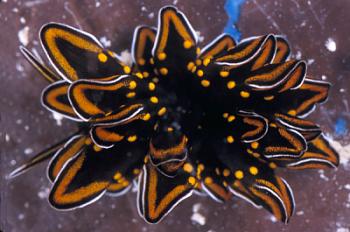
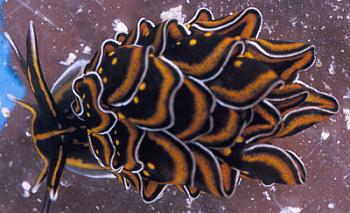
Hi Bill,
For those interested in distributions, here's an couple of images of Cyerce nigricans I found on Huahine, French Polynesia. I found it 1 m into the ocean from the shore in less than half a meter water depth on some filamentous algae
[Details: 4526 Cyerce nigricans French Polynesia, Huahine, VIII 2000. artificial on brown background in plexiglass container Provia 100F, 80mmM, T-32, dorsal. Specimen in LACM collection. Off Aaruba Camping, on filamentous algae, 0.5 m.]
Daniel
dgeiger@nhm.org
Geiger, D.L., 2000 (Dec 15) Cyerce nigricans from French Polynesia. [Message in] Sea Slug Forum. Australian Museum, Sydney. Available from http://www.seaslugforum.net/find/3308Thanks Daniel,
I'll put the rest of your beautiful images from French Polynesia up in the next few days
Bill Rudman.
Cyerce nigricans from Heron Island
December 12, 2000
From: John Walker
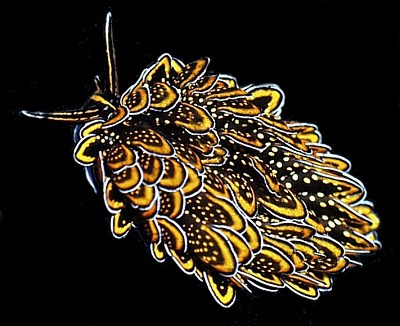
Dear Bill
I was browsing your seaslug site and noticed the message from Julie Marshall (who is on Heron Island at present [Great Barrier Reef, Queensland]). I photographed a specimen there last week and thought you might like another picture. It was collected on the reef flat on the north side of the island (near the Blue Pools) on Wednesday October 25th. I have just returned from 2 weeks there, photographing all kinds of invertebrates for a CD-ROM I am making on invertebrate diversity.
Best wishes
John
jwalker@mail.usyd.edu.au
Walker, J., 2000 (Dec 12) Cyerce nigricans from Heron Island. [Message in] Sea Slug Forum. Australian Museum, Sydney. Available from http://www.seaslugforum.net/find/3269Thanks John,
I look forward to seeing the CD Rom when it is finished.
Bill Rudman.
Cyerce nigricans from Heron Island
July 14, 1999
From: Julie Marshall
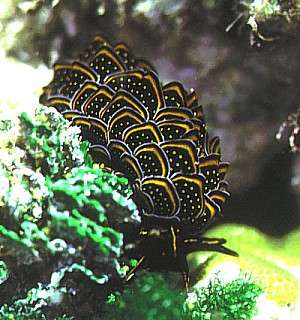
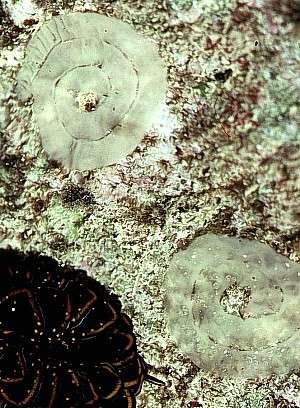
Hi Bill,
A couple of weeks ago you asked for some other photos of Cyerce nigricans. This is a photo of an animal found intertidally in the mid reef area at Heron Island [Great Barrier Reef] and and also one of an egg mass found on a different occasion in September 1994. This egg mass was one of number found under a dead coral slab at the reef crest together with three animals. I have found Cyerce nigricans a number of times at Heron Island, usually intertidally, either on or close to its food, the green alga, Chlorodesmis fastigiata.
Best wishes
Julie Marshall
j.marshall@latrobe.edu.au
Marshall, J., 1999 (Jul 14) Cyerce nigricans from Heron Island. [Message in] Sea Slug Forum. Australian Museum, Sydney. Available from http://www.seaslugforum.net/find/1063Dear Julie,
Thanks for the photos. With help from you and Clay Carlson we now have some nice photos of Cyerce nigricans. I'm glad you had the egg mass photo, as these flattened spirals are a good sign that a sacoglossan is around. However although most dorids ahve the egg ribbon attached along one edge, there are a few dorids such as Chromodoris striatella which have egg ribbons like this lying flat on the substrate.
Best wishes,
Bill Rudman.
